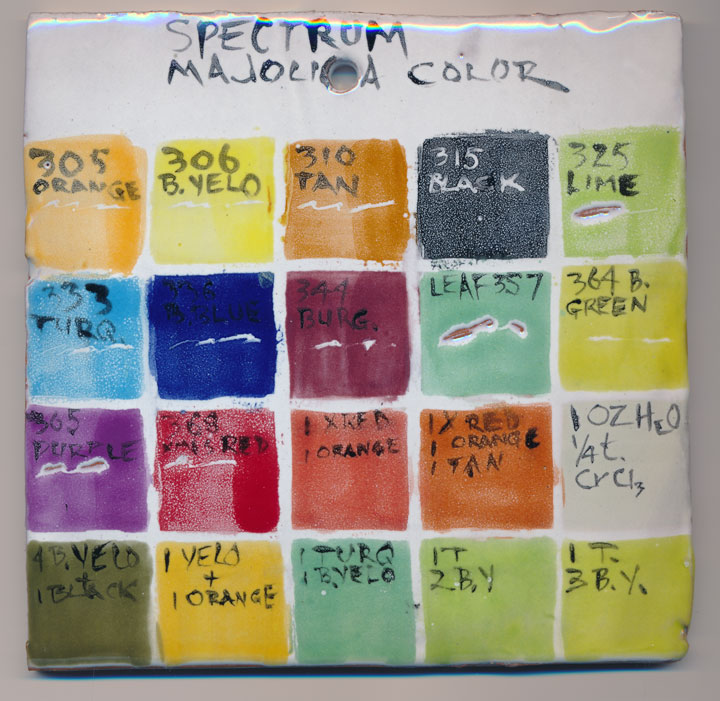AMACO has announced that it’s GDC line of color for majolica decoration will be discontinued in December. It may be available through specific suppliers through the following year, but production will cease. These have been my go-to colors, supplemented here and there, for a number of years, so I’m sad to see them go. It was not a profitable line for AMACO – we use these in small amounts and there were 36 colors. There was at one point discussion about making fewer, more inter-mixable colors, but the final decision was that they were focusing elsewhere in the product line. My thanks to AMACO and its good people for the conversation and support over the years I’ve used the GDCs. I’ve appreciated the product line and my relationship with the company’s people.
Before the GDCs, I mixed my own colors. This began with Gerstley borate as a flux, mixed with oxides or stains. The GB kept things in suspension, made brushing easy, and gave a firm surface when dry to wax over. BUT, the GB gave a very tiny reticulation of miniscule white snowflakes in melting that pastelled the colors. Even before the announcements of the GB mine closing, I was aware that people using frit for a flux had brighter, denser color on majolica. Switching to frit + color or stain revealed that this mix alone was very powdery when dry, and made a real mess if handled, or waxed over – smearing, smudging. Pete Pinnell, the Mister Rogers of clay and glaze materials, advised adding a bit of bentonite, and that did take care of the problems. The colors brushed better and were firm enough to wax over when dry. I’ve been experimenting with adding glycerin or CMC gum for added brushability, but too much of that makes the mix gloppy and interferes with crisp line quality. Still looking for the sweet spot. the mixes I was using:
- Oxides that melt well at low fire (copper, cobalt, manganese, iron) are mixed by volume (say, teaspoons) 1 colorant + 1 frit (I used 3124 because it’s in the glaze I use) = 1/2 bentonite.
- More refractory (resistant to melting) oxides (chrome, rutile, nickel) or stains are mixed by volume 1 part colorant + 3-4 parts frit + 1/2 bentonite.
Bentonite “bloats” in water – like trying to mix cinnamon or cocoa powder with liquids – so mix dry with other materials and then add water. Screen if lumpy. There are some nice, small test sieves that fit in a pint container available at the ceramic suppliers.
I have some tests in mind with varying the bentonite and CMC, and trying Veegum-Cer, which the commercial people use in their colors. The last iteration of the GDCs seemed over-gummed and a bit gloppy for good line quality to me, so it’s a needed push out of the nest to do my own testing.
There are other commercial products. I was just given a sample of Spectrum Majolica colors. I fire to 03, and at 03, some of the colors are broken and seem over-fluxed. See image below. The top 3 rows are the Spectrum colors, the last block to the right in row 3 is a test of chrome chloride and water (a soluble colorant toxic raw), and the bottom row is mixes of the Spectrum colors I was curious about, as I had open squares on my test tile.
Mayco has product for this as well. More later on this. My testing life is s-l-o-w as we are in the busy last part of the semester at school, and I’m also being treated with i.v. antibiotics for Lyme disease. I hope people who have experience with other products will comment.

It is exciting to see the results of the spectrum colors. I would like to control the spotting like you see in the red and black samples. What is the fix for eliminating the spotting?
I think you’d have to use a glaze that fired lower to control the reticulation. The A.R.T. Glazewerks Maiolica colors don’t break up on my glaze at 03, nor do the Mayco Stroke and Coat colors.